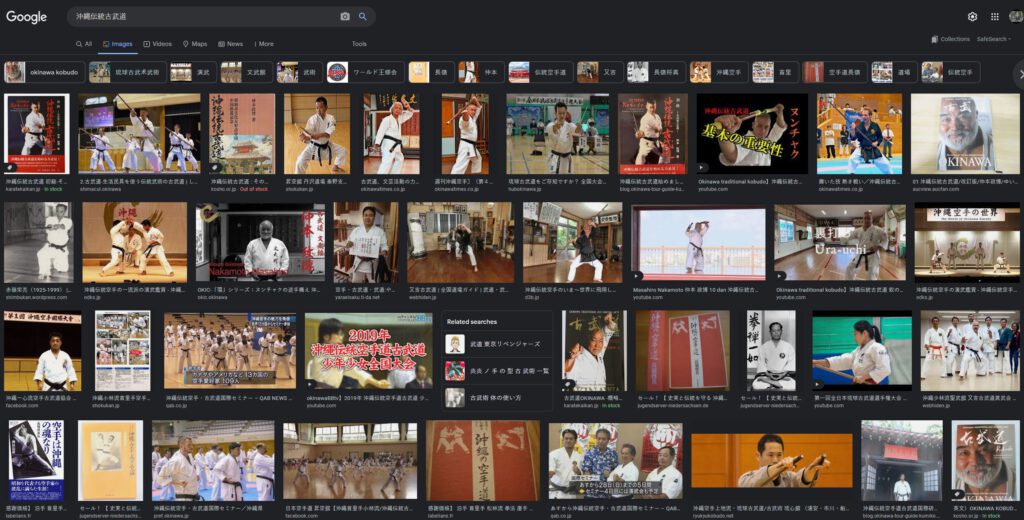About three years ago, Mamoru Nakamoto Sensei posted a number of short lectures on his Karate Kobudo Channel. The videos have since been taken down again, but I had prepared a synopsis for each and these are posted below. Note that these are NOT official or complete translations, but just to give you a better understanding of kobudo-specific terminology.
1. Short Lecture on Okinawa Traditional Kobudo: Prerequisites for [consideration as] Okinawa Traditional Kobudo
Synopsis: To be considered Okinawa Traditional Kobudo, the following four prerequisites shall be met:
- It was created/devised in Okinawa.
- It has been a tradition for a long time already.
- It uses old weapons handed down in Okinawa.
- At minimum, the teacher of one’s predecessor is clearly known.
2. Short Lecture on Okinawa Traditional Kobudo: The Inheritance/Succession of the Tradition is a Combination of Self-training and Personal Instruction
Synopsis: Only self-training without personal instruction might be a martial art, but without being traditional.Vice versa, personal instruction only, without self-training, might be traditional, but will hardly make you a true martial artist.Therefore, for Okinawa Kobudo to be fully considered traditional, it has to be a combination of self-training and personal instruction.
3. Short Lecture on Okinawa Traditional Kobudo: The Issue of Superiority/Inferiority and Comparison
Synopsis: While they all belong to Karate, there is Okinawa Karate, Japanese Karate, and KARATE (i.e. an otherwise arbitrary form of punching and kicking in a dogi).In Kobudo, there are the Taira Shinken lineage and Matayoshi lineage, among others: They have their own a specific tradition (persons, techniques …) and spirit.There are different people with different characters and culture, such as Japanese people, or foreigners.Don’t use the one against the other.
4. Short Lecture on Okinawa Traditional Kobudo: Karate and Kobudo are one Body
Synopsis: Originally, Karate and Kobudo were one.Since the Meiji Restoration, Karate was one individual entity, and Kobudo was one individual entity, with a gap between the two.Currently, Karate and Kobudo are two parts of a entity, without the previous gap between them. It so becomes again what it was originally, Karate and Kobudo as one body.
5. Short Lecture on Okinawa Traditional Kobudo: The Practice Ratio of Karate and Kobudo
Synopsis: As regards the practice ratio of Karate and Kobudo, the following can be said:
- In general, internationally only Karate is practiced.
- The practice of Kobudo is something rather special or unique.
- In Okinawa, the practice ratio is about 4/5 Karate vs 1/5 Kobudo
- The ideal practice ratio would be 50% Karate and 50% Kobudo.
6. Short Lecture on Okinawa Traditional Kobudo: How to get started in Okinawa Traditional Kobudo
Synopsis: People usually start Karate and when they have learned it sufficiently, they may start with Kobudo. Often it remains considered separated.It is good to first advance in Karate, so you already know the stances, terminology etc. and have gained sufficient athleticism. Once your advanced in Karate, you start Kobudo as a beginner, and from there you advance in Kobudo.Finally, the experience from Kobudo will reflect back into your Karate and will improve it, too. Finally, Karate and Kobudo mutually and continuously improve each other.
7. Short Lecture on Okinawa Traditional Kobudo: Tips for Finding a Dojo
Synopsis: The persons who wants to start Kobudo may use the following tips to find a dojo:
- Visit Several dojo.
- Check the lineage of the tradition.
- What Kata do you prefer? How’s the Dojo atmosphere? How’s the instructor?
- Membership fees
- Distance and time it takes to get to the dojo (do I want to go far away?)
8. Short Lecture on Okinawa Traditional Kobudo: The Mutual Benefits of Karate and Kobudo
Synopsis: Empty hand vs empty hand is what is done in Karate.Weapon vs weapon is what is done in Kobudo.One of the benefits mutual benefits of Karate and Kobudo is that empty hand vs weapon as well as weapon vs empty hand are considered.(for instance: Considerations of empty hand vs weapon might be helpful for you when you are attacked by an armed person. Considerations of weapon vs empty hand might be helpful for you when you are attacked by some much stronger, younger, more athletic than you.)
9. Short Lecture on Okinawa Traditional Kobudo: The Designation of “Okinawa Traditional Kobudo.”
Synopsis: First of all, both designation and content of “Okinawa Traditional Kobudo” has to be differentiated from “Japanese Traditional Kobudo”.The designation “Okinawa Traditional Kobudo” may include the names Ryukyu or Okinawa as well as Kobudo or Kobujutsu. So there are a number of typical names used to describe Kobudo, for instance
- • Okinawa Kobudo
- • Okinawa Kobujutsu
- • Ryukyu Kobudo
- • Ryukyu Kobujutsu
While the designation might differ from dojo to dojo, it means the same thing. The designation “Okinawa Traditional Kobudo” is a generic term for all of these.
© 2022, Andreas Quast. All rights reserved.

